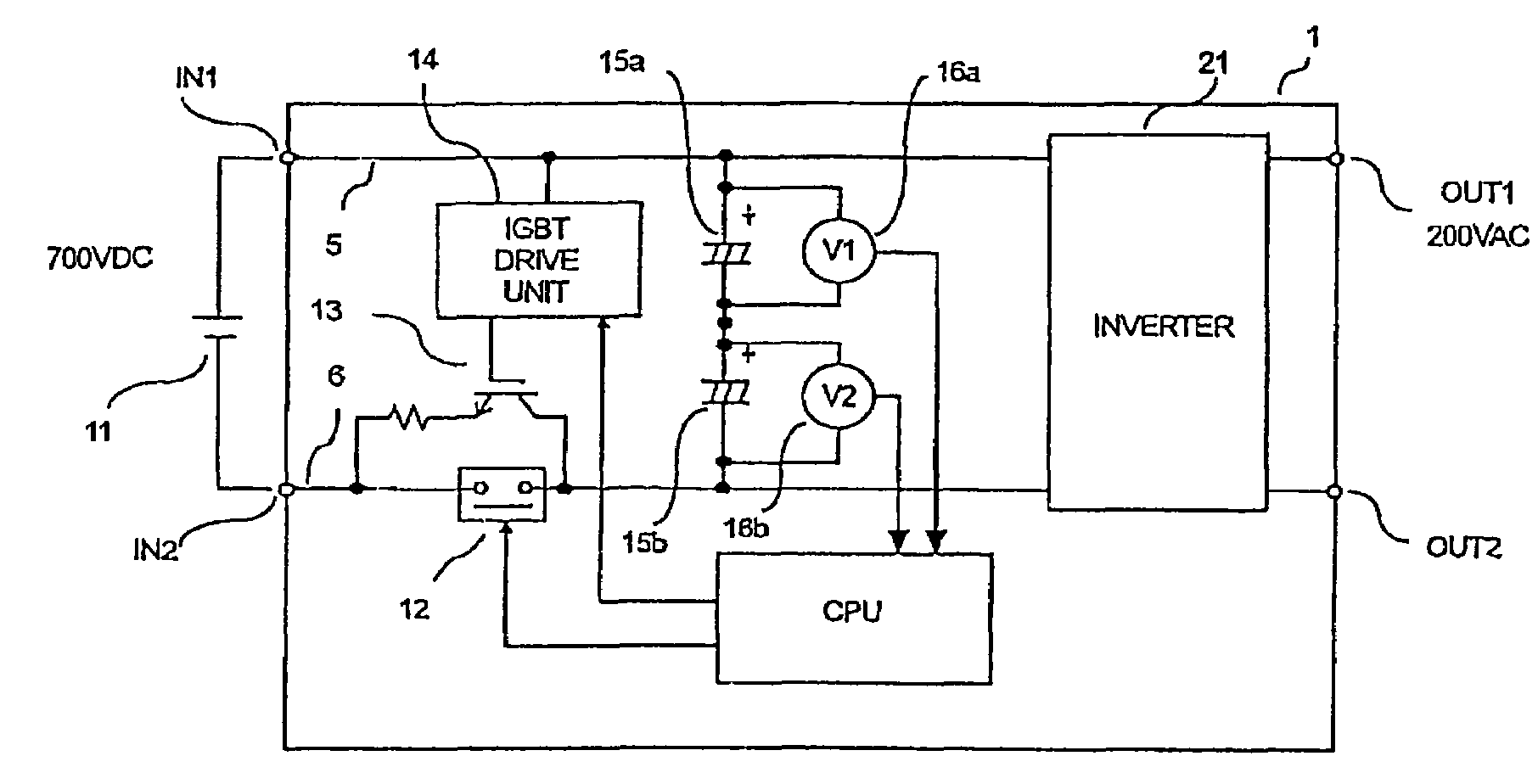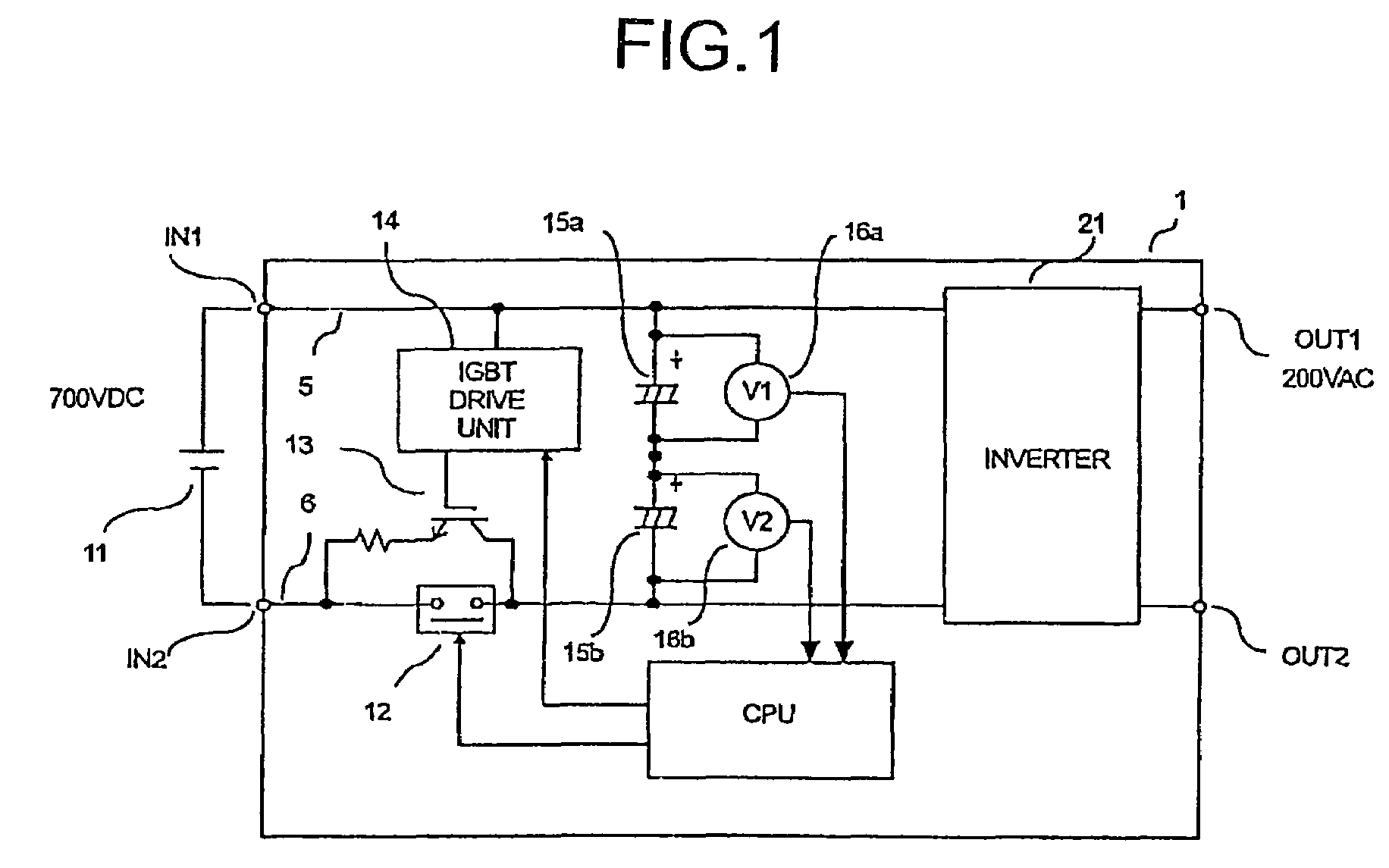Interconnection inverter device
a technology of inverter and inverter, which is applied in the direction of electric variable regulation, process and machine control, instruments, etc., can solve the problems of shock, difficulty in adopting home electric appliances, etc., and achieve the effect of safe stopping the devi
- Summary
- Abstract
- Description
- Claims
- Application Information
AI Technical Summary
Benefits of technology
Problems solved by technology
Method used
Image
Examples
first embodiment
[0032]FIG. 1 is a circuit diagram of an interconnection inverter device 1 according to a first embodiment of the present invention. The interconnection inverter device 1 is configured as a power system in such a manner that its input terminals IN1 and IN2 are connected to a solar cell 11 which is a direct-current power supply and power is interconnected to an alternating-current power system (not shown) through its output terminals OUT1 and OUT2 which are alternating current output terminals. In the solar cell 11 as the direct-current power supply, serial and parallel combinations of cells can arbitrarily be configured. Therefore, an output voltage can be set in a wide range from tens of VDC to hundreds of VDC.
[0033]The circuit configuration of the interconnection inverter device 1 according to the first embodiment shown in FIG. 1 is explained below. The interconnection inverter device 1 includes component units such as an inverter 21, a switching element 13 such as IGBT (Insulated ...
second embodiment
[0045]FIG. 3 is a circuit diagram of an interconnection inverter device 30 according to a second embodiment of the present invention. The interconnection inverter device 30 is configured, based on the configuration according to the first embodiment of FIG. 1, to include a converter 25, which changes (to boost voltage and / or to step down voltage) an input voltage supplied from the solar cell 11, provided in the input stage of the inverter 21. The rest parts of the configuration are the same as or equivalent to these of the configuration according to the first embodiment shown in FIG. 1, and therefore, the same reference numerals are assigned to those component units, and explanation thereof is omitted.
[0046]In FIG. 3, the converter 25 includes coils 17a and 17b, switching elements 18a and 18b such as IGBT, diodes 19a and 19b, and capacitors 20a and 20b. In the converter 25, the switching element 18a and the switching element 18b are connected in series to be inserted between the bus ...
third embodiment
[0051]FIG. 4 is a circuit diagram of an interconnection inverter device 40 according to a third embodiment of the present invention. The interconnection inverter device 40 is configured, based on the configuration according to the first embodiment of FIG. 1, so that three or more capacitors (three in the example of FIG. 4) are inserted between the bus 5 and the bus 6. The rest parts of the configuration are the same as or equivalent to these of the configuration according to the first embodiment shown in FIG. 1, and therefore, the configuration except the main component units is omitted from FIG. 4, and explanation thereof is omitted.
[0052]In FIG. 3, the capacitors 15a, 15b, and a capacitor 15c (C1, C2, C3) are connected in series to be inserted between the bus 5 and the bus 6. Based on this configuration, even if a short-circuit fault occurs in any one of the capacitors, the breakdown voltage can be ensured by the remaining two capacitors. If three or more capacitors are connected,...
PUM
 Login to View More
Login to View More Abstract
Description
Claims
Application Information
 Login to View More
Login to View More - R&D
- Intellectual Property
- Life Sciences
- Materials
- Tech Scout
- Unparalleled Data Quality
- Higher Quality Content
- 60% Fewer Hallucinations
Browse by: Latest US Patents, China's latest patents, Technical Efficacy Thesaurus, Application Domain, Technology Topic, Popular Technical Reports.
© 2025 PatSnap. All rights reserved.Legal|Privacy policy|Modern Slavery Act Transparency Statement|Sitemap|About US| Contact US: help@patsnap.com



